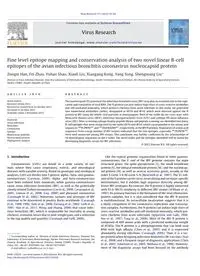
2013 Fine level epitope mapping and conservation analysis of two novel linear B-cell epitopes of the avian infectious br PDF
Preview 2013 Fine level epitope mapping and conservation analysis of two novel linear B-cell epitopes of the avian infectious br
Virus Research 171 (2013) 54– 64 Contents lists available at SciVerse ScienceDirect Virus Research journa l h o me pag e: www.elsevier.com/locate/virusres Fine level epitope mapping and conservation analysis of two novel linear B-cell epitopes of the avian infectious bronchitis coronavirus nucleocapsid protein Zongxi Han, Fei Zhao, Yuhao Shao, Xiaoli Liu, Xiangang Kong, Yang Song, Shengwang Liu ∗ Division of Avian Infectious Diseases, State Key Laboratory of Veterinary Biotechnology, Harbin Veterinary Research Institute, the Chinese Academy of Agricultural Sciences, Harbin 150001, People’s Republic of China a r t i c l e i n f o Article history: Received 29 July 2012 Received in revised form 22 October 2012 Accepted 23 October 2012 Available online 2 November 2012 Keywords: Avian infectious Bronchitis Coronavirus Epitope Monoclonal antibody Nucleocapsid protein Phylogenetic analysis a b s t r a c t The nucleocapsid (N) protein of the infectious bronchitis virus (IBV) may play an essential role in the repli- cation and translation of viral RNA. The N protein can also induce high titers of cross-reactive antibodies and cell-mediated immunity, which protects chickens from acute infection. In this study, we generated two monoclonal antibodies (mAbs), designated as 6D10 and 4F10, which were directed against the N protein of IBV using the whole viral particles as immunogens. Both of the mAbs do not cross react with Newcastle disease virus (NDV), infectious laryngotracheitis virus (ILTV) and subtype H9 avian influenza virus (AIV). After screening a phage display peptide library and peptide scanning, we identified two linear B-cell epitopes that were recognized by the mAbs 6D10 and 4F10, which corresponded to the amino acid sequences 242FGPRTK247 and 195DLIARAAKI203, respectively, in the IBV N protein. Alignments of amino acid sequences from a large number of IBV isolates indicated that the two epitopes, especially 242FGPRTK247, were well conserved among IBV strains. This conclusion was further confirmed by the relationships of 18 heterologous sequences to the 2 mAbs. The novel mAbs and the epitopes identified will be useful for developing diagnostic assays for IBV infections. © 2012 Elsevier B.V. All rights reserved. 1. Introduction Coronaviruses (CoVs) are found in a wide variety of ani- mals where they cause respiratory, enteric, and neurological diseases with variable severity. Based on genotypic and serological analyses, CoVs are divides into 3 genera; alpha-, beta- and gamma- coronaviruses (Carstens, 2009). Alpha- and beta-coronaviruses have been isolated from mammals, while gamma-coronaviruses cause avian infectious bronchitis (IBV), as well as the genetically closely related Turkey coronavirus (Cao et al., 2008; Cavanagh et al., 2001; Gomaa et al., 2008; Guy, 2000) and pheasant coronavirus (Cavanagh et al., 2002). Numerous variants and serotypes of IBV continue to be discovered in poultry flocks worldwide (Cavanagh et al., 1988, 1992; Dolz et al., 2006; Farsang et al., 2002; Gelb et al., 1991; Han et al., 2011; Wang and Huang, 2000) that cause infec- tious bronchitis (IB), which is responsible for mortality in young chickens, economic losses due to poor weight gain, and a reduction in the egg quality and quantity (Cavanagh and Gelb, 2008). ∗ Corresponding author at: Division of Avian Infectious Diseases, National Key Laboratory of Veterinary Biotechnology, Harbin Veterinary Research Institute, the Chinese Academy of Agricultural Sciences, Harbin 150001, People’s Republic of China. Tel.: +86 451 85935065; fax: +86 451 82734181. E-mail address:
